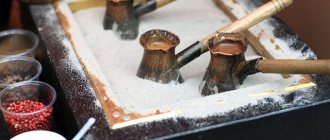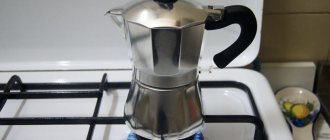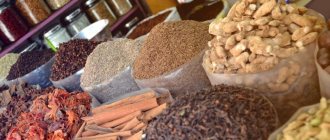When the beans are ground in a home coffee grinder in a larger volume than is necessary for one preparation of the drink or the vacuum packaging is opened, after some time they are exhausted and the drink partially loses its taste characteristics. To store ground coffee at home and ensure that the product does not lose its original properties, you need to provide the right conditions and select a suitable container.
How to properly store coffee at home
The assessment of coffee quality is determined by the results of organoleptic analysis in terms of appearance, color, aroma and taste. The ground and soluble product is obtained through special processing of natural grains.
The maximum amount of oils in grains can preserve the nutritional content for a long time.
Instant coffee prepares faster than ground coffee. However, in terms of aroma and taste, the ground freshly brewed drink is more rich and pleasant.
Coffee is adversely affected by 4 main factors that negatively affect its quality:
- Light.
Constant direct light and sunlight, being a catalyst for unwanted chemical processes, lead to the loss of aroma and taste of coffee;
- Air.
The quickly volatile oils contained in the grains are destroyed upon contact with air due to oxidation;
- Temperature.
High temperatures evaporate the oil contained in coffee and destroy the caffeine;
- Humidity.
The hygroscopic properties of the product are capable of absorbing moisture from the air with further loss of taste and aroma.
General rules for storing coffee at home are to comply with the following requirements:
- darkened closed location;
- maintaining 50-60% humidity;
- do not exceed the ambient temperature above 23°C;
- contents in special bags, packaging, containers with an airtight tight-fitting lid.
During long-term storage, coffee may lose its taste and aroma. It is most reasonable to buy a small amount of the product that you can drink in 1-2 weeks.
The difference between a good product and a bad one
The main criterion that suggests that coffee has gone bad is the smell. Externally, the grain, ground or instant drink changes little over time. But the aroma, on the contrary, can either disappear completely or become rancid or sour. The difference in taste is also not always noticeable; moreover, drinking an expired drink in most cases is not dangerous, especially if we are talking about raw beans, and it even retains an invigorating effect due to the caffeine content.
Grain
A sign of marriage is empty and brittle grains
In addition to the obvious deterioration of the appearance of unroasted beans: mold, sour or musty odor and dried edges, a stale product reveals a lack of taste and aroma after roasting. The grains are brittle and empty inside. With high humidity, on the contrary, rotten beans may appear in the bag.
But heat-treated ones, on the contrary, only harden over time and are difficult to grind. They acquire too dark a color due to the oxidation of oily substances, which also give stale grains a rancid smell. In addition, such grains shine unnaturally and stick together.
Coffee beans affected by pests
If it’s a pity to part with roasted coffee beans that have lain idle for a long time and have lost their freshness and aroma, you can use them to decorate interior items: photo frames, coasters, flower pots, flower vases, etc. This will give ordinary items an interesting twist, and the grains will not go to waste.
Ground
Spoiled ground coffee has a lumpy consistency.
Stale powder will have a non-uniform consistency - lumps in the packaging arise due to long-term storage at high humidity, in addition, the coffee can “melt” and solidify into a single solid mass. It is especially unpleasant if there are any living creatures in the ground drink; this type of coffee is the most suitable for the reproduction of unpleasant creatures.
Soluble
The most resistant type of coffee drink to changes over time. Obvious signs of an expired product are traces of mold and mildew.
Clumping and caking of the granules will also indicate that the shelf life has expired. The smell of stale instant coffee becomes sour or is completely lost. But unpleasant living creatures are found in it extremely rarely, this is due to the peculiarities of production: the low content of essential oils and chemical additives repel parasites.
There is mold and cobwebs in the packaging.
Currently, there are not a single case of poisoning from stale coffee. However, this does not mean that it can be stored carelessly and for a long time. As with any organic product, toxins accumulate and chemical reactions occur. Of course, one cup of such a drink will not do much harm, but systematic use can lead to problems with digestion and liver.
Storing Roasted Coffee Beans at Home
Roasted coffee beans are a delicate product that cannot be stored for long. When using multi-layer vacuum packaging, the oxidation process is prevented: the contained gas vent valve removes carbon dioxide from the roasted beans.
The packaging is carefully closed and does not allow air inside. Opened vacuum packaging should be used for up to 3 weeks.
You can extend the shelf life of an opened coffee package in the refrigerator by placing it in a glass container. A glass jar with a tight lid not only ensures better preservation of the grains, but also protects against foreign odors.
Shelf life of roasted beans:
- in vacuum packaging - 12 months;
- in a glass jar - up to 6 months;
- in opened store packaging −14 days.
Deadlines
Green, unroasted coffee lasts the longest. In a cool, dry place it can last for more than a year. But only real gourmets get this look.
Roasted coffee beans have a much shorter shelf life - no more than two weeks. Freezing will help increase its shelf life. To do this, place the coffee beans into portioned bags, carefully squeeze out all the air from there and put them in the freezer. Remember that defrosted coffee cannot be stored and must be used immediately.
Ground coffee in unopened factory packaging can be stored for about a year. Once the package is opened, it must be consumed within 5 days. Instant coffee is stored in original packaging a little longer - about two years.
Now you know what you need to pay attention to when storing coffee. And here the main assistant will be a correctly selected container. It will help protect coffee from excess moisture, protect it from exposure to sunlight, contact with air and unnecessary odors. By adhering to the basic rules, you can enjoy your favorite drink and not worry about its aroma and richness of taste.
Where can you store ground coffee?
After grinding, the vulnerability of the coffee increases significantly. At home, it can be stored in the same containers in which it was purchased. Special packaging optimally protects against the effects of negative factors:
- factory sealed packaging - 10-12 months;
- vacuum packaging - 18 months;
- multilayer bag with valve - 12 months;
- jar with a tight-fitting lid - 12 months;
- foil package - 12-14 months.
Open packaging preserves the quality of ground coffee for up to 10 days.
How to store instant?
Instant coffee is a short-lived product. It contains a small amount of natural substances that give coffee its unforgettable aroma.
When opening the purchased product, it is better to pour it into a sealed glass container. Opened packaging retains the properties of coffee for up to 1 week, provided it is tightly closed during use.
Shelf life of instant coffee:
- original packaging - up to 2 years;
- glass jar with an airtight lid - 24 months;
- tin can - 18-24 months.
The impact of expired coffee on human health
Some brave souls claim that it is impossible to get poisoned from expired coffee. Actually this is not true. Even though the actual shelf life of coffee exceeds the shelf life, sometimes old coffee can cause illness or food poisoning.
You should not drink coffee if:
- natural coffee has become damp, acquired a musty smell, and become moldy. A drink made from such grains can cause stomach upset, nausea, and vomiting;
- The coffee smells like rancid fat. Spoiled oils are harmful to the liver. This coffee is especially dangerous for people with gallbladder diseases;
- expired instant coffee causes heartburn and indigestion.
Table of shelf life of coffee at a certain temperature
| t, °C | Raw coffee | Grains | Ground | Soluble | ||||
| Package | ||||||||
| Closed | Open | Freshly ground | Closed | Open | Closed | Open | ||
| From 0 to −20 | 3 years | 3 years | 2 months | cannot be stored | 2-3 years | 15-30 days | 5 years | 1 year |
| 13-16 | 2 years | 2 years | 10 days | 2 days | 6-18 months | 10-14 days | 3 years | 4-5 months |
| 25-35 | 10 months | 6 months | 1 day | 3-5 hours | 3-6 months | 5 days | 18 months | 1 year |
Storage space
The kitchen cabinet is the most ideal home place to store coffee. A prerequisite for such a cabinet must be distance from the sink, stove, window, and tightly closed doors.
On the shelf, next to coffee, you need to exclude the proximity of spices, herbs, dried fruits and other strong-smelling products.
In the absence of a hood, it is better to place the coffee at the middle level of the kitchen height, where the optimal temperature and humidity levels are located.
The refrigerator is not the best place to store coffee. The presence of foreign odors and temperature changes have a bad effect on the quality of the drink. The freezer provides a shock method for freezing hermetically sealed portion bags. With this method, all the qualities of coffee are preserved for up to 2 months. A portion is taken out as needed - this eliminates the possibility of re-freezing the package.
Recommendations for storing in the refrigerator and freezer
The freezer is one of the possible places to store coffee beans. They can be either raw or fried. Moreover, in the second case, freezing should be “shock” and carried out immediately after heat treatment.
One of the options for long-term storage is the freezer
It is not worth storing a large number of grains in one package at once. In this case, every time you want to drink a cup of coffee, you will have to remove the beans from the cold and keep them warm for a while, then return them back to the freezer shelf. Such temperature changes will turn the grains into a tasteless and odorless product within a couple of months.
It is better to package them in small portions and defrost as needed. It is very important, after the grains are warm, to allow them to thaw on their own: you should not heat them in the microwave or place them near heating appliances. Grinding half-frozen beans is also not a good idea. The optimal temperature for grains ready for further processing and grinding is 15 degrees.
It is better to freeze in small portions; before grinding the grains, you need to defrost them completely.
Even in a frozen state, grains are extremely susceptible to odors, so products with a strong odor, such as fish, meat, seafood, etc., should be kept as far away as possible, otherwise an off-flavor in the finished drink cannot be avoided.
Coffee Tips
- It is not recommended to use plastic or metal storage containers, from which the coffee acquires a specific smell.
- The refrigerator is not suitable for short-term storage of coffee.
- After being frozen, the grains are warmed at room temperature.
- Avoid storing coffee on a windowsill or near a heating installation.
Its rich taste and unique aroma depend on proper storage of coffee. Attentive attention to the contents of everyone’s favorite drink and adherence to storage rules will allow you to pamper yourself and your loved ones with a bright variety of coffee varieties.











